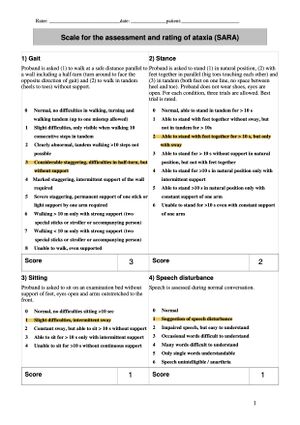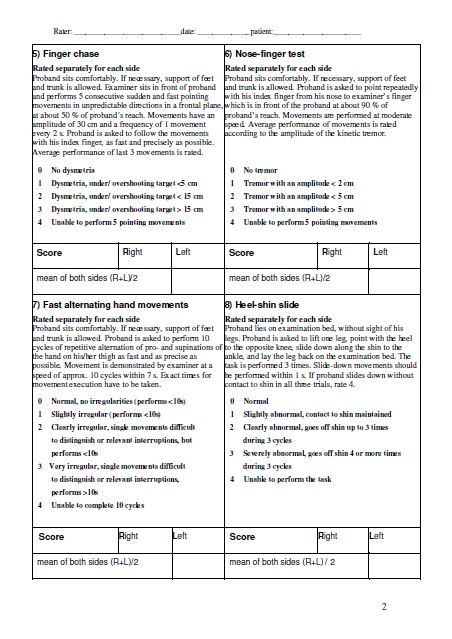It has eight unequally weighted items evaluating to gait stance sitting speech finger-chase test nose-finger test fast alternating movements and heel-shin test. A higher score indicates a greater level of disability.

Cerebellar Ataxia A Case Study Physiopedia
1 Gait 2 Stance 3 Sitting 4 Speech disturbance 5 Finger chase 6 Nose-finger test 7 Fast alternating hand movements 8 Heel-shin slide Number of Items 8 Equipment Required Stopwatch.

. To describe the audiological and electrophysiological results in patients with spinocerebellar ataxia SCA. Turkish version of the Scale for the Assessment and Rating of Ataxia SARA-T consists of 8 items examining the following. 12 It consists of eight items among which gait sitting and the standing sub-components are related to balance.
Impaired dexterity is a frequently reported disability among people with ataxic multiple sclerosis MS. Magnetic resonance imaging MRI or. PC1 PC2 Gender binary AAO and the length in normal and expanded CAG repeats.
This condition happens when the part of the brain called the cerebellum is damaged. METHODS A systematic literature search was conducted to identify the instruments used to rate ataxia symptoms. Which of the following is not a method used during a physical.
To report the course of ataxia in children up to 2 years post-operatively following surgical resection of a posterior fossa tumour PFT. There are several types of ataxia including. The CA assessment was performed through the following steps.
The SARA and the BARS are reliable and valid measures of ataxia for children with PFT 13. CBC Creatinine Liver Enzymes Electrophoresis ESR CRP TFT Vitamin B12 Cholestrol helps to evaluate overall health and detect a range of disorders inculding infection and heavy metal poisoning 3. Ataxia is a non-specific clinical manifestation implying dysfunction of the parts of the nervous system that coordinate movement such as the cerebellum.
DIAGNOSTIC INVESTIGATIONS Haematology. Ataxia is a lack of muscle coordination which may affect speech eye movements the ability to swallow walking picking up objects and other voluntary movements. A diagnostic approach to ataxia may include.
International Cooperative Ataxia Rating Scale-measures 19 specific movements on an ordinal scale ranging from 0no ataxia to 100most severe ataxia-Separated into. The SARA is a clinical scale based on a semiquantitative assessment of cerebellar ataxia. To quantify and standardize the evaluation of upper extremity coordination disorder among patients with multiple sclerosis MS using the Tablet Ataxia Assessment Program TAAP.
Ataxia is a neurological syndrome characterised by clumsy and unco-ordinated movement of the limbs trunk and cranial muscles. Ataxia was quantified using the Brief Ataxia Rating Score which ranged from 7 to 26 of 30. Anamnesis and otolaryngologic exam pure tone audiometry acoustic immittance measures and brainstem.
Ataxia might be observed which relates to. Retrospective and cross-sectional studies were performed. The scores are based on patient performance of.
Ataxia is a term used for a group of neurological conditions. Posture and gait Limb movements Speech Oculomotor 2. All statistical analyses were performed using SPSS version 200 SPSS Inc Chicago IL.
The ICARS Scores range from 0 to 100. Methods Thirty -ve children median age 9 years range 415 having resection of PFT were assessed using the Scale for the. Finally predictors of the progression of ataxia were assessed using the following independent variables.
An uncoordinated wide base walk its considered. Thirty-five children median age 9 years range 4-15 having resection of PFT were assessed using the Scale for the Assessment and Rating of Ataxia SARA Brief Ataxia Rating Scale BARS and the mobility domain of the. 1 gait 08 2 stance 06 3 sitting 04 4 speech disturbance 06 5 finger chase 04 6 the nose-finger test 04 7 fast alternative hand movement 04 and 8 heelshin slide 04.
Purpose To report the course of ataxia in children up to 2 years post-operatively following surgical resection of a posterior fossa tumour PFT. The aim of this review and meta-analysis was to review i the studies that evaluated cognition domains in FRDA ii explore possible relationships between clinical genetic and imaging structural and functional characteristics and neuropsychological assessment as well as iii the longitudinal evolution of cognitive change in FRDA. Scale for assessment and rating of ataxia-tests fewer items thus less burdensome for clinicians to complete.
Blood tests to rule out specific deficiencies and toxins. CEREBELLAR ATAXIA NITHIN NAIR 2. Forty-three patients were assessed using the following procedures.
The SARA is used in clinical paediatrics and has age-based normative reference values 14. Neurological and medical examinations. Children were assessed using the Scale for the Assessment and Rating of Ataxia SARA scale 11 and the Brief Ataxia Rating Scale BARS scale 12.
Proprioception at the knee joint was assessed using passive joint angle matching in 18 patients and 14 age-matched controls. The three sub-components of balance are scored out of 18 SARAbal. SARA is an 8-item performance based scale yielding a total score of 0 no ataxia to 40 most severe ataxia.
Is which of the following. Urine screen for mercury exposure. Family history of neurological problems.
Besides conducting a physical exam and a neurological exam including checking your vision balance coordination and reflexes your doct. We assessed whether proprioceptive disturbances can explain the ataxia. 5 patients with cerebellar ataxia were also studied.
We assessed the clinimetric properties of ataxia rating scales and functional tests and made recommendations regarding their use. Oculomotor functions are not included in the SARA. The X and Y axis movements of 50 MS patients and.
The FARS consists of three subscales comprising a general score for ataxia a score for activities of daily living ADL and a neurological examination. The scores can be added to make a total score ranging from 0 to 159. The full scale is scored out of 40.
Neurological and medical history including drug and toxin exposures. An important method of assessment in which the practitioner observes the patients appearance gate behavior etc. Motion Inputs generated by nine instrumented tests that mimic the nine standard bedside clinical tests of CA covering the 5 domains.
Ataxia telangiectasia AT episodic ataxia Friedreichs ataxia multiple system atrophy MSA and spinocerebellar ataxia. It results from pathology in the cerebellum and its connections or in the proprioceptive sensory pathways. Follow Ataxia diagnosis and assessment 1.
If you have ataxia your doctor will look for a treatable cause. The SARA is an ataxia severity rating measure.

Scale For The Assessment And Rating Of Ataxia Sara Physiopedia

Pdf Objective Assessment Of Cerebellar Ataxia A Comprehensive And Refined Approach

S4 Sample 24 1 Cardiac Risks Communication Skills Risk Factors Heart Disease

Scale For The Assessment And Rating Of Ataxia Sara Assessment Scale Friedreich S Ataxia
0 Comments